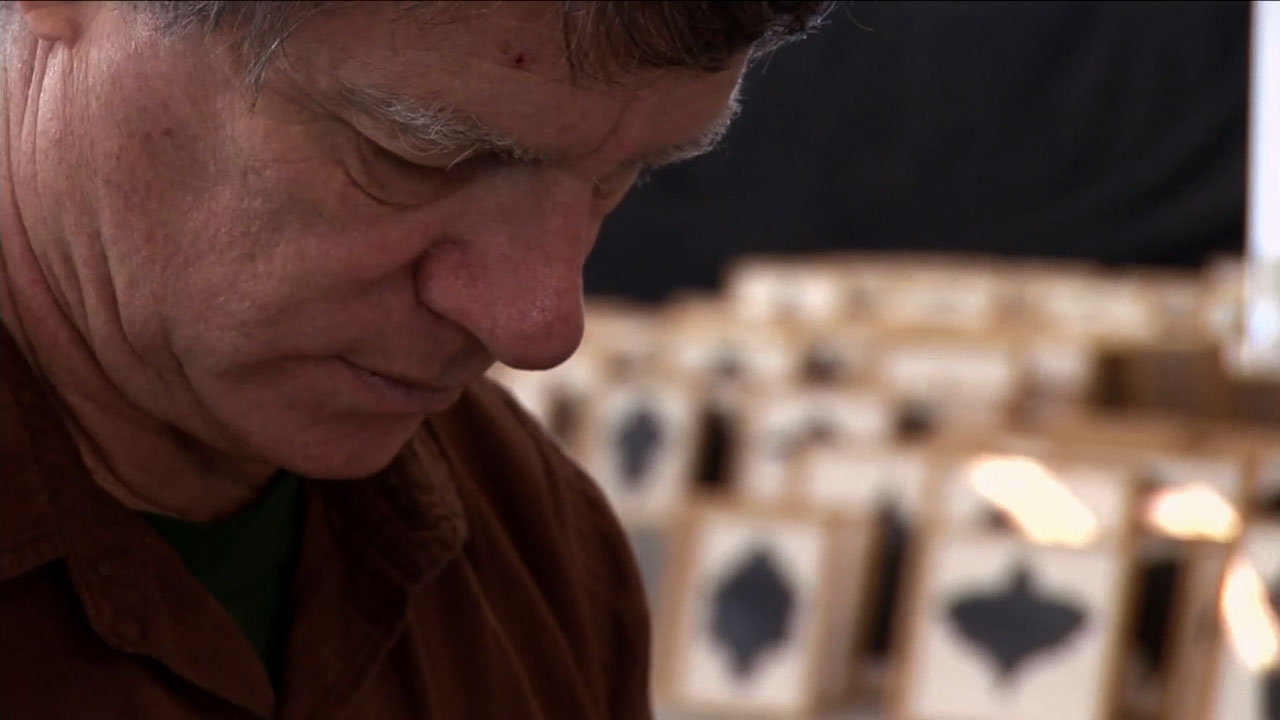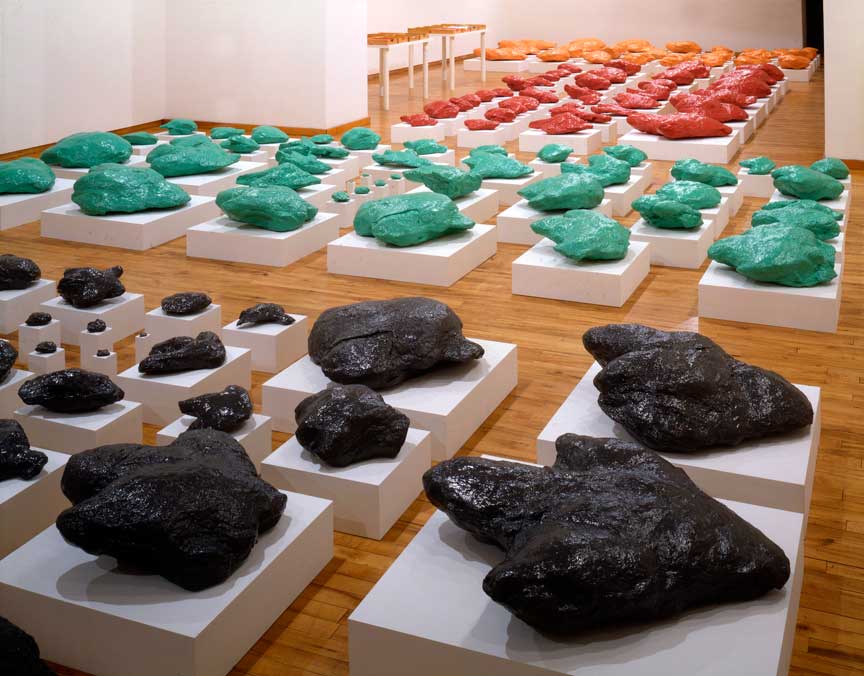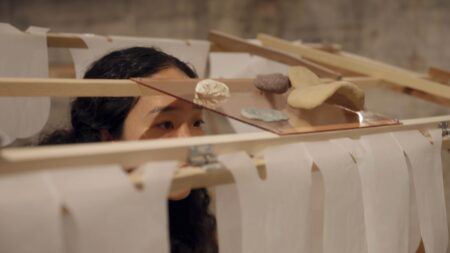Interview
In Charge of His Own Destiny

Production still from the "Art in the Twenty-First Century" Season 5 episode, "Systems," 2009. © Art21, Inc. 2009.
What prompted Allan McCollum to become an artist? In this interview, conducted in 2009 at his New York City studio, McCollum reflects on his path and the many different influences along the way, from his famous uncle to post-war mass production to science fiction.
Art21: How did you come to the idea of being an artist?
McCollum: I didn’t think of being an artist until I was twenty-four years old. That’s when I started reading and learning about art. Everyone in my family had some kind of artistic interest. Most of them knew how to draw in some way or another. When I look back on my childhood in a working class suburb, so many men of my father’s generation had a workshop in the garage and they would fantasize that maybe, one day, they would invent something and not have to work in the factory anymore. I’m sure some of them achieved that, but not all of them. This idea of having a little workshop in the home is I think somewhere at the root of deciding I wanted to have a studio. It didn’t come from going to museums and wanting to be whatever you want to be when you’re learning about contemporary art. It wasn’t about trying to get into the textbooks because I was a great critical thinker. It had to do with wanting to be in business for myself and in charge of my own destiny in some way, to make things that I could sell to make a living. The connection to factory labor and those kinds of things is very clear to me.
Art21: What about your uncle who did the program called Learning To Draw?
McCollum: Yes, my uncle Jon Gnagy had a television program on Saturday mornings—fifteen minutes of teaching you how to draw a landscape, portrait of a dog, or something like that. It was a wonderful program. I watched it every weekend.
Jon Gnagy grew up in one of those utopian religious communities where everybody knew how to do everything. It was his thinking that no one should be able to say, “I can’t draw” or “I don’t know how to sing” or “I don’t know how to play an instrument.” He thought we should all share in that. He had a very liberal outlook on class-oriented society and it was what he was constantly saying on television: “All you need to do is know is how to draw a circle and a cube and a sphere and a cone. If you can do that, then you can draw anything.” He would sell you on how you could be an artist. It was great. He had to be an influence on me.
Jon Gnagy lived in New York at that time, but visited us in California on holidays and occasionally would help us draw. I didn’t know him well, but I was extremely impressed with him—he was my uncle and he was on television. I didn’t associate him with contemporary art though and he didn’t talk about contemporary art. When he made references to fine art, he’d mention Cezanne. It wasn’t until I started becoming an artist that we got to talking and I realized he did know about abstract painting and who the artists were. He had just chosen not to be that. I intuited from him that he never painted or drew anything unless he could teach someone else how to do it. Without even verbalizing it, I think this became a law in my head, because as an artist I have never done anything that I couldn’t easily show someone else how to do.
Art21: Another thing that seems to play a big part in your work is the drama of quantities. The project can go on and on and on. What is that about? Where does that come from?
McCollum: When I first started making the Surrogate Paintings I was working very hard trying to figure out how to make them seem like a symbol that stood for a painting. One of the solutions I came up with was to make a lot of them so that any one of them just seemed like a small part of the whole. We grow up in a world filled with huge quantities of things, not only objects made by factories, but grains of sand, tree leaves, etcetera. Repetition is a huge part of daily life. And there’s a pleasure in it or we wouldn’t do it. I felt there was prejudice against including that in art and I found myself resisting this prejudice. I wanted to work in quantities and make things that were singular and unique at the same time. You can’t say that something is unique or that something that’s the same as something else is not unique. They’re both sides of the same coin. I wanted to sort of resolve that on a higher level. But there is, as you said, the drama of thousands of things. It can be nightmarish or it can be a wonderful feeling of abundance. Some people want to run out of a room when there are too many objects to look at and other people stand there in awe.
I grew up during the Cold War and it’s interesting when you think back on the number of newsreels, magazine articles, and things on television that showed huge quantities of production. Americans wanted to show that they could produce thousands of automobiles and raise fields and fields of wheat and feed thousands of people. There were constantly shots of mass production and factory work. And they made it look very beautiful. I think that growing up with this constant imagery of productivity, love of productivity, and pride in productivity probably influenced everyone in my generation.

Allan McCollum. Plaster Surrogates, 1982/83. Enamel on cast Hydrostone; variable dimensions. Installation view of From the Permanent Collection at Marian Goodman Gallery, New York. © Allan McCollum. Courtesy of the artist.
Art21: Can you talk more specifically about how production in popular culture filtered into your life?
McCollum: My parents worked at a number of different factories. My mother worked at the Frito Company for a while. She would bring home bags of Fritos that she got at half price or less than half price. To this day, when I see a bag of Fritos I think I have a different response to them than someone whose mother didn’t work in the Frito factory. My parents worked in a ceramics factory for a while, too. We had plates that came from the factory where they worked. There are families that work in factories and find pleasure in it.
Art21: Did this experience in your childhood give you a certain fondness for repetitive imagery, shape, or color?
McCollum: Repetition is something I have always enjoyed. My parents participated in little theater groups and in one of their plays, every time a door opened on the set somebody would throw torn up bits of paper so it looked like the actor or actress was coming in from a snowstorm. For some reason it became my mother’s job to tear up all the little bits of paper. Me and my parents and brother and sister all sat around tearing up little bits of newspaper. We went on doing it for hours. Now I guess it’s boring, but when you’re a child it’s kind of exciting. It’s a game. That is one of my very first memories. So I guess there is some sort of joy in my mind when I think of working together to produce lots of things.
Art21: Did you make things when you were a kid, other than the paper snow?
McCollum: I liked to draw when I was a child. I was especially interested in drawing comic strips. I would fold a piece of paper to make squares and then draw a little picture in each box. I was also a huge science fiction fan all through my childhood. The idea of objects multiplying themselves like crazy comes right out of science fiction. I was very interested in three-dimensional animation and influenced by special effects artists like Ray Harryhausen, the animator who did movies like Mighty Joe Young (1949), The Beast From 20,000 Fathoms (1953), and The 7th Voyage of Sinbad (1958). He spent months making something that only lasted one minute on the screen. The idea of patience, making little tiny moves to create a spectacle, always interested me and I think you could define a lot of what I’ve done that way—a lot of tiny little gestures, patience, and boredom that wind up with something that’s spectacular and fun to look at. It’s as if to put value on repetitive labor instead of devaluing it.

Allan McCollum. Natural Copies from the Coal Mines of Central Utah, 1994/95. Enamel paint on cast polymer-enhanced Hydrocal; variable dimensions. Produced in collaboration with the College of Eastern Utah Prehistoric Museum, Price, Utah. Installation view at John Weber Gallery, New York. Photo by Fred Scruton. © Allan McCollum. Courtesy of the artist.
Art21: There’s something about scientific investigation that requires constantly pushing one small thing forward, which you seem to be doing in your work. You seem interested in the underlying structures of things—is that the case?
McCollum: What intrigued me about science fiction is how we determine what’s real and what isn’t. I think this led me to be not so much interested in science, but in sociology and anthropology where you learn that different cultures define reality in totally different ways. That wonderful feeling of watching a science fiction movie, and that kind of analysis of structure—what’s real and what isn’t—led me to think about the systematic way we order the universe in our brains. The way we organize society. The ways we decide which objects are more important than other objects or which people are more important than other people. How we determine the place of a chair versus the place of a lamp versus the place of an artwork?
When I became an artist I learned very quickly that I was not interested in formalist issues or the history of painting—how a painting related to the paintings that came before it or the paintings that might come after it. I was interested in how a painting wound up in a gallery or museum and all of the social aspects that determine the way we value things. I was interested in the structure of a couch, a table, a lamp or a potted plant as well as the painting. I was interested in how we define ourselves through artworks and also through other things like antiques or fossils or emblems that represent our city or state or country. It all goes back to an interest cultural structure.
Interviewer: Susan Sollins. Interview conducted: February 2009. Published: September 2013. Content Editor: Nicole J. Caruth. © Art21, Inc.



